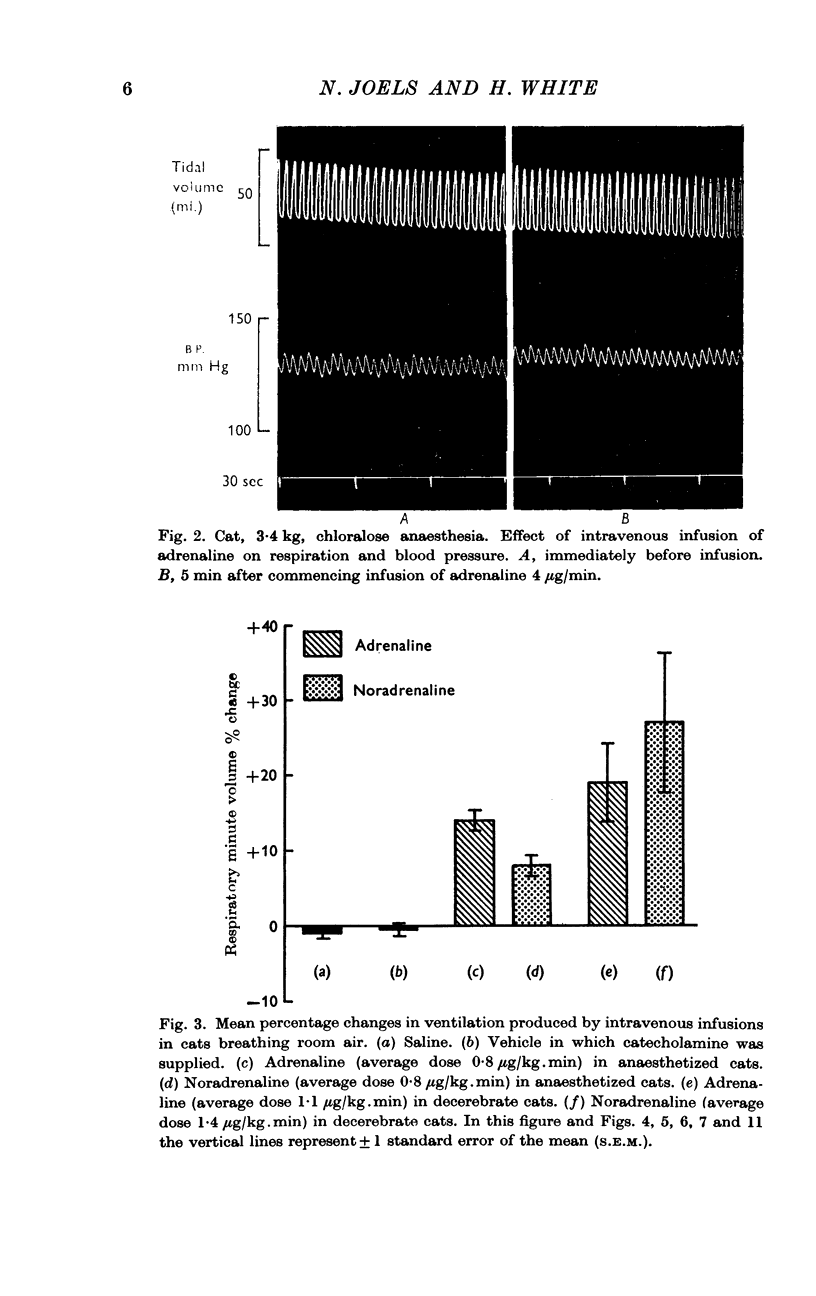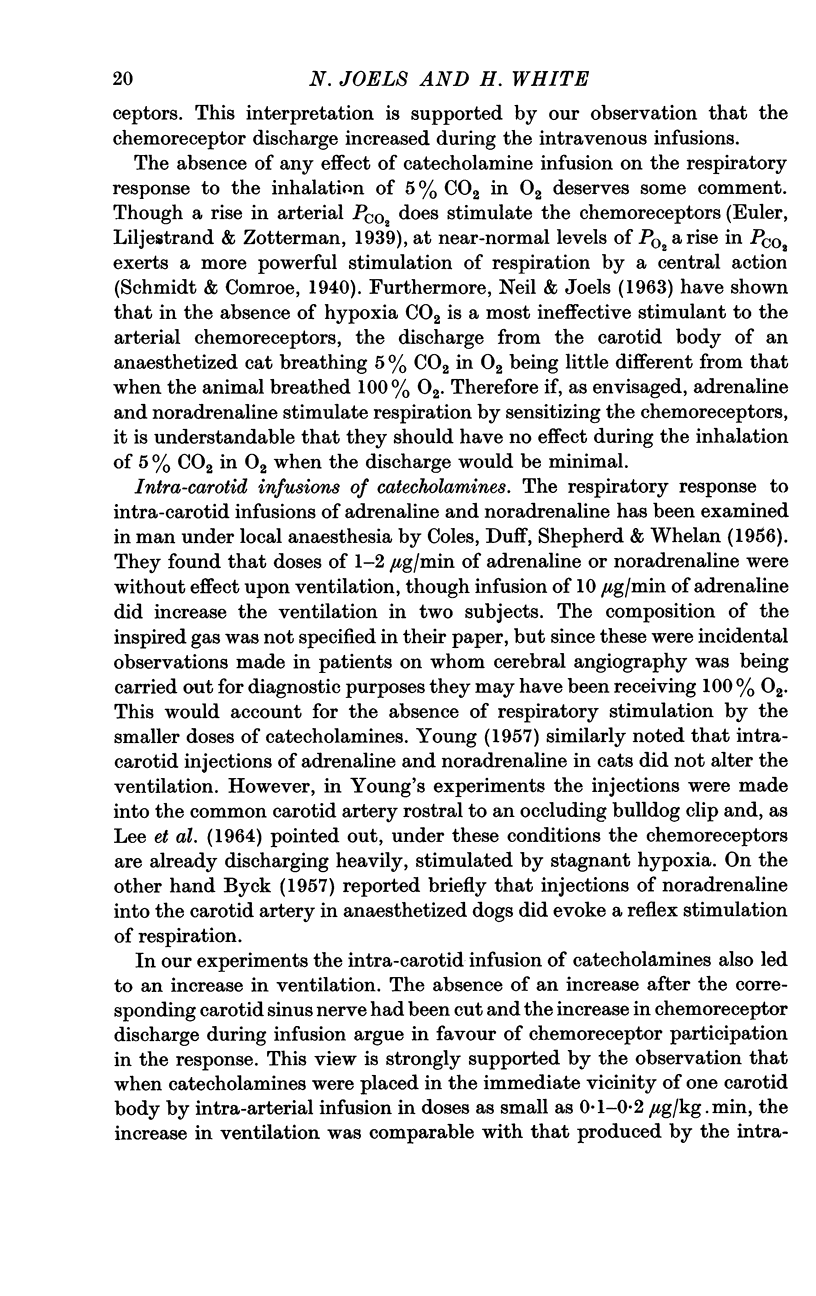Abstract
1. Intravenous infusions of adrenaline and noradrenaline in doses averaging 0·8 μg/kg.min increased the respiratory minute volume of anaesthetized cats breathing room air. The mean increase in respiratory minute volume was 14% during adrenaline infusion and 8% during noradrenaline infusion.
2. In a small group of decerebrate cats infusions of adrenaline and noradrenaline increased ventilation by 19 and 27% respectively.
3. Intravenous catecholamine infusions also increased the respiratory responses of anaesthetized animals to the inhalation of 5% or 10% O2 in N2 and to the inhalation of 5% CO2 in air.
4. Adrenaline and noradrenaline infusions had no significant effect on the ventilation of animals breathing 100% O2, nor did they significantly alter the respiratory response to the inhalation of 5% CO2 in O2.
5. After section of the carotid sinus and aortic nerves, a blood-pressure compensator being used to minimize changes in arterial pressure, catecholamines had no effect on the respiration of cats breathing air.
6. An increase in carotid body chemoreceptor discharge accompanied the increase in ventilation during catecholamine infusion.
7. Intravenous catecholamine infusions still produced an increase in ventilation and carotid body chemoreceptor discharge after both aortic nerves and both cervical sympathetic nerves had been cut.
8. Intra-arterial infusions into one carotid artery of 0·2 μg/kg.min of adrenaline or 0·1 μg/kg.min of noradrenaline led to mean increases in respiratory minute volume of 9·9 and 11·5% respectively. No increase occurred after section of the corresponding carotid sinus nerve. Such infusions also evoked an increase in carotid body chemoreceptor discharge.
9. It is concluded that the hyperpnoea produced by adrenaline and noradrenaline infusions in the cat is predominantly reflex in origin and is mediated by the arterial chemoreceptors.
10. The increase in ventilation produced by adrenaline appears to have a component additional to its effect upon the chemoreceptors though the nature of this action has not been identified.
Full text
PDF






















Selected References
These references are in PubMed. This may not be the complete list of references from this article.
- BARCROFT H., BASNAYAKE V., CELANDER O., COBBOLD A. F., CUNNINGHAM D. J., JUKES M. G., YOUNG I. M. The effect of carbon dioxide on the respiratory response to noradrenaline in man. J Physiol. 1957 Aug 6;137(3):365–373. doi: 10.1113/jphysiol.1957.sp005819. [DOI] [PMC free article] [PubMed] [Google Scholar]
- COLES D. R., DUFF F., SHEPHERD W. H., WHELAN R. F. The effect on respiration of infusions of adrenaline and noradrenaline into the carotid and vertebral arteries in man. Br J Pharmacol Chemother. 1956 Sep;11(3):346–350. doi: 10.1111/j.1476-5381.1956.tb01079.x. [DOI] [PMC free article] [PubMed] [Google Scholar]
- CUNNINGHAM D. J., HEY E. N., LLOYD B. B. The effect of intravenous infusion of noradrenaline on the respiratory response to carbon dioxide in man. Q J Exp Physiol Cogn Med Sci. 1958 Oct;43(4):394–399. doi: 10.1113/expphysiol.1958.sp001352. [DOI] [PubMed] [Google Scholar]
- CUNNINGHAM D. J., HEY E. N., PATRICK J. M., LLOYD B. B. The effect of noradrenaline infusion on the relation between pulmonary ventilation and the alveolar PO2 and PCO2 in man. Ann N Y Acad Sci. 1963 Jun 24;109:756–771. doi: 10.1111/j.1749-6632.1963.tb13504.x. [DOI] [PubMed] [Google Scholar]
- DE BURGH DALY M., LAMBERTSEN C. J., SCHWEITZER A. Observations on the volume of blood flow and oxygen utilization of the carotid body in the cat. J Physiol. 1954 Jul 28;125(1):67–89. doi: 10.1113/jphysiol.1954.sp005143. [DOI] [PMC free article] [PubMed] [Google Scholar]
- FLOYD W. F., NEIL E. The influence of the sympathetic innervation of the carotid bifurcation on chemoceptor and baroceptor activity in the cat. Arch Int Pharmacodyn Ther. 1952 Sep 1;91(1-2):230–239. [PubMed] [Google Scholar]
- Gaddum J. H., Peart W. S., Vogt M. The estimation of adrenaline and allied substances in blood. J Physiol. 1949 Jun 15;108(4):467–481. doi: 10.1113/jphysiol.1949.sp004350. [DOI] [PMC free article] [PubMed] [Google Scholar]
- LANDGREN S., NEIL E. Chemoreceptor impulse activity following haemorrhage. Acta Physiol Scand. 1951 Aug 25;23(2-3):158–167. doi: 10.1111/j.1748-1716.1951.tb00805.x. [DOI] [PubMed] [Google Scholar]
- LEE K. D., MAYOU R. A., TORRANCE R. W. THE EFFECT OF BLOOD PRESSURE UPON CHEMORECEPTOR DISCHARGE TO HYPOXIA, AND THE MODIFICATION OF THIS EFFECT BY THE SYMPATHETIC-ADRENAL SYSTEM. Q J Exp Physiol Cogn Med Sci. 1964 Apr;49:171–183. doi: 10.1113/expphysiol.1964.sp001717. [DOI] [PubMed] [Google Scholar]
- Langley J. N. Observations on the physiological action of extracts of the supra-renal bodies. J Physiol. 1901 Oct 16;27(3):237–256. doi: 10.1113/jphysiol.1901.sp000869. [DOI] [PMC free article] [PubMed] [Google Scholar]
- NEIL E., REDWOOD C. R. M., SCHWEITZER A. Pressor responses to electrical stimulation of the carotid sinus nerve in cats. J Physiol. 1949 Sep;109(3-4):259–271. doi: 10.1113/jphysiol.1949.sp004390. [DOI] [PMC free article] [PubMed] [Google Scholar]
- Oliver G., Schäfer E. A. The Physiological Effects of Extracts of the Suprarenal Capsules. J Physiol. 1895 Jul 18;18(3):230–276. doi: 10.1113/jphysiol.1895.sp000564. [DOI] [PMC free article] [PubMed] [Google Scholar]
- SOKOLOFF L. The action of drugs on the cerebral circulation. Pharmacol Rev. 1959 Mar;11(1):1–85. [PubMed] [Google Scholar]
- WHELAN R. F., YOUNG I. M. The effect of adrenaline and noradrenaline infusions on respiration in man. Br J Pharmacol Chemother. 1953 Mar;8(1):98–102. doi: 10.1111/j.1476-5381.1953.tb00759.x. [DOI] [PMC free article] [PubMed] [Google Scholar]
- Wright S. Action of adrenaline and related substances on respiration. J Physiol. 1930 Jun 27;69(4):493–499. doi: 10.1113/jphysiol.1930.sp002665. [DOI] [PMC free article] [PubMed] [Google Scholar]
- YOUNG I. M. Some observations on the mechanism of adrenaline hyperpnoea. J Physiol. 1957 Aug 6;137(3):374–395. doi: 10.1113/jphysiol.1957.sp005820. [DOI] [PMC free article] [PubMed] [Google Scholar]


